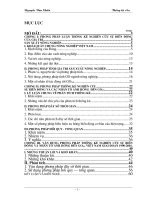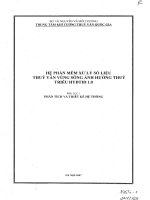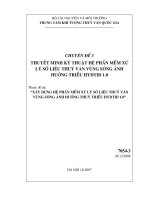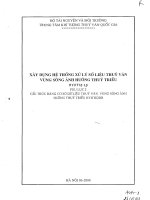Ảnh hưởng của môi trường nuôi cấy đến khả năng tổng hợp IAA của chủng vi khuẩn nội sinh HY9 và TT3
Bạn đang xem bản rút gọn của tài liệu. Xem và tải ngay bản đầy đủ của tài liệu tại đây (9.98 MB, 9 trang )
Vietnam J. Agri. Sci. 2022, Vol. 20, No. 12: 1640-1648
Tạp chí Khoa học Nơng nghiệp Việt Nam 2022, 20(12): 1640-1648
www.vnua.edu.vn
Phạm Hồng Hiển1, Trần Thị Đào2, Tạ Hà Trang2, Hoàng Thị Liễu2, Nguyễn Văn Giang2*
1
Viện Khoa học Nông nghiệp Việt Nam
Khoa Công nghệ sinh học, Học viện Nông nghiệp Việt Nam
2
*
Tác giả liên hệ:
Ngày nhận bài: 24.06.2022
Ngày chấp nhận đăng: 22.11.2022
TĨM TẮT
Vi khuẩn nội sinh là nhóm vi khuẩn sinh trưởng và phát triển bên trong mô thực vật, không gây hại cho cây chủ.
Chúng góp phần cải thiện sự phát triển của cây thông qua tổng hợp IAA, siderophore, hồ tan phosphate và tăng
cường tính kháng bệnh của cây. Nghiên cứu này được thực hiện nhằm mục đích đánh giá ảnh hưởng của pH, nhiệt
độ, nguồn carbon, nitơ và thời gian nuôi cấy đến nồng độ IAA được tổng hợp bởi hai chủng vi khuẩn nội sinh HY9 và
TT3 được phân lập từ rễ cây kim ngân (Lonicera japonica). Trong các điều kiện nuôi cấy khác nhau, nồng độ IAA
cao nhất của hai chủng vi khuẩn nội sinh HY9 và TT3 đạt được tại pH = 7 (lần lượt là 42,9 µg/ml và 49,07 µg/ml),
35C (53,49 µg/ml và 56,73 µg/ml), 4 ngày nuôi (51,47 µg/ml và 53,76 µg/ml). Nguồn carbon thích hợp là saccharose
và nguồn nitơ là NH4Cl. So sánh trình tự nucelotide 16S rRNA của chủng vi khuẩn nội sinh TT3 với các trình tự
nucleotide 16S rRNA của các chủng vi khuẩn trên ngân hàng gen (GenBank) cho phép kết luận chủng TT3 có quan
hệ rất gần với chủng Klebsiella variicola strain 1, do đó chủng TT3 được đặt tên là Klebsiella variicola TT3.
Từ khoá: Cây kim ngân, vi khuẩn nội sinh, IAA, Klebsiella spp.
Effects of Culture Conditons on IAA Synthetic Ability
of Endophytic Bacterial Strains HY9 and TT3
ABSTRACT
Endophytic bacteria living in the plant tissues support plant growth by synthesizing IAA and siderophore,
inorganic soluble phosphate, and increasing disease resistance of the host plants. This study aimed to evaluate the
effects of carbon and nitrogen sources, pH, temperature, and time of incubation on the concentration of IAA
synthesized by two endophytic bacterial strains, HY9 and TT3, isolated from Lonicera japonica. Under various
suitable culture conditions, maximum IAA of HY9 and TT3 strains was produced at pH = 7 (42.9 µg/ml and
49.07 µg/ml, respectively), 35C (53.49 µg/ml and 56.73 µg/ml), and 4 days of incubation (51.47 µg/ml and
53.76 µg/ml). The suitable carbon and nitrogen sources were saccharose and NH4Cl. Comparing the nucleotide
sequence of 16S rRNA of TT3 strain with nucleotide sequences of 16S rRNA of other bacterial strains on GenBank
revealed that TT3 strain had a very closed relationship with Klebsiella variicola strain 1, thus, strain TT3 was
named Klebsiella variicola TT3.
Keywords: Lonicera japonica, Endophytes, IAA, Klebsiella spp.
1640
Phạm Hồng Hiển, Trần Thị Đào, Tạ Hà Trang, Hoàng Thị Liễu, Nguyễn Văn Giang
1641
Ảnh hưởng của môi trường nuôi cấy đến khả năng tổng hợp IAA của chủng vi khuẩn nội sinh HY9 và TT3
Đồ thị đường chuẩn IAA
1,8
y = 0,0175x - 0,0288
R² = 0,9957
1,6
1,4
OD530nm
1,2
1
0,8
0,6
0,4
0,2
0
-0,2 0
20
40
60
80
100
Nồng độ IAA (µg/ml)
µ
1642
Phạm Hồng Hiển, Trần Thị Đào, Tạ Hà Trang, Hoàng Thị Liễu, Nguyễn Văn Giang
µ
µ
µ
µ
µ
µ
µ
µ
µ
HY9
TT3
HY9
50
Nồng độ IAA (µg/ml)
Nồng độ IAA (µg/ml)
60
40
30
20
10
0
pH4
pH5
pH6
pH
(A)
pH7
80
70
60
50
40
30
20
10
0
-10
30
35
40
45
TT3
50
pH8
Nhiệt độ (C)
(B)
1643
Ảnh hưởng của môi trường nuôi cấy đến khả năng tổng hợp IAA của chủng vi khuẩn nội sinh HY9 và TT3
µ
µ
µ
µ
µ
µ
µ
µ
1644
HY9
TT3
Nồng độ IAA (µg/ml)
45
40
35
30
25
20
15
10
5
0
HY9
50
45
40
35
30
25
20
15
10
5
0
-5
Nguồn carbon
TT3
Nguồn nitơ
(A)
(B)
60
Nồng độ IAA(µg/ml)
Nồng độ IAA (µg/ml)
Phạm Hồng Hiển, Trần Thị Đào, Tạ Hà Trang, Hồng Thị Liễu, Nguyễn Văn Giang
53,76
49,07
50
51,47
38,27
40
47,58
42,9
41,36
36,04
30
19,47
20
10
HY9
18,27
TT3
0
Ngày 1
Ngày 2
Ngày 3
Ngày 4
Ngày 5
Thời gian nuôi cấy (ngày)
1645
Ảnh hưởng của môi trường nuôi cấy đến khả năng tổng hợp IAA của chủng vi khuẩn nội sinh HY9 và TT3
TT3
Klebsiella variicola strain 1
Klebsiella sp. SS107E
Klebsiella sp. G3
Klebsiella variicola strain R25
Klebsiella variicola strain SK01
Klebsiella variicola strain NM43 TS4-1
Klebsiella sp. N13
Klebsiella variicola strain EFK1
Klebsiella pneumoniae strain Lor-MGB-YQ-2(3)
Klebsiella sp. 2009I3
Klebsiella pneumoniae subsp. pneumouniae strain BT2501
Klebsiella sp. N61
Klebsiella sp. strain P5
Klebsiella sp. NB-91
Klebsiella sp. NB-90
0,0050
µ
µ
µ
µ
µ
µ
µ
µ
µ
1646
µ
Phạm Hồng Hiển, Trần Thị Đào, Tạ Hà Trang, Hoàng Thị Liễu, Nguyễn Văn Giang
Apine O.A. & Jadhav J.P. (2011). Optimization of
medium for indole-3-acetic acid production using
Pantoea agglomerans strain PVM. Journal of
Applied Microbiology. 110(5): 1235-1244.
Bộ Khoa học và Công nghệ (2015). TCVN
10784:2015. Vi sinh vật - Xác định khả năng sinh
tổng hợp axit 3-indol-acetic (IAA).
Chandra S., Askari K. & Kumari M. (2018).
Optimization of indole acetic acid production by
isolated bacteria from Stevia rebaudiana
rhizosphere and its effects on plant growth. Journal
of Genetic Engineering and Biotechnology.
16(2): 581-586.
Duca D., Lorv J., Patten C.L., Rose D. & Glick B.R.
(2014). Indole-3-acetic acid in plant-microbe
interactions.
Antonie
Van
Leeuwenhoek.
106(1): 85-125.
Đỗ Tất Lợi (2001). Những cây thuốc và vị thuốc Việt
Nam. Nhà xuất bản Y học.
Emami E., Alikhani H.A., Pourbabaei A.A., Etesami
H., Sarmadian F. & Motessharezadeh B. (2019)
Assessment of the Potential of Indole-3-Acetic
Acid Producing Bacteria to manage Chemical
Fertilizers Application. International Journal of
Environmental Research. 13: 603-611.
Fouda A., Eid A.M., Elsaied A., El-Belely E.F.,
Barghoth M.G., Azab E., Gobouri A.A. & Hassan
S.E.D.
(2021).
Plant
Growth-Promoting
Endophytic Bacterial Community Inhabiting the
Leaves of Pulicaria incisa (Lam.) DC Inherent to
Arid Regions. Plants. 10(1): 76.
Glickmann E. & Dessaux Y. (1995). A critical
examination of the e specificity of the Salkowski
reagent for indolic compounds produced by
phytopathogenic
bacteria.
Applied
and
Environmental Microbiology. 61(2): 793-796.
Karthik M., Pushpakanth P., Krishnamoorthy R. &
Senthilkumar M. (2017). Endophytic bacteria
associated with banana cultivars and their
inoculation effect on plant growth. Journal of
Horticultural Science and Biotechnology. 92(6): 1-9.
Khamna S., Yokota A., Peberdy J.F. & Lumyong S.
(2010). Indole-3-acetic acid production by
Streptomyces sp. Isolated from some Thai
medicinal plant rhizosphere soils. Eurasian Journal
of Biosciences. 4(4): 23-32.
Kumari S., Prabha C., Singh A., Kumari S. & Kiran S.
(2018). Optimization of Indole-3-Acetic Acid
Production by Diazotrophic B. subtilis DR2
(KP455653), Isolated from Rhizosphere of
Eragrostis cynosuroides. Int. J. Pharm. Med. Biol.
Sci. 7(2): 20-27.
Lin L., Wei C., Chen M., Wang H., Li Y., Li Y., Yang
L. & An Q. (2015). Complete genome sequence of
endophytic nitrogen-fixing Klebsiella variicola
strain DX120E. Standards in Genomic Sciences.
pp. 10-22.
Longfei Z., Yajun X., Xin-He L., Changjuan S.,
Zhenshan D. & Yuliang J. (2015). Screening and
characterization of endophytic Bacillus and
Paenibacillus strains from medicinal plant
Lonicera japonica for use as potential plant growth
promoters. Brazilian Journal of Microbiology.
46(4): 977-989.
Marag P.S. & Suman A. (2018). Growth stage and
tissue specific colonization of endophytic bacteria
having plant growth promoting traits in hybrid and
composite maize (Zea mays L.). Microbiological
Research. 214: 101-113.
Mohite B. (2013). Isolation and characterization of
indole acetic acid (IAA) producing bacteria from
rhizospheric soil and its effect on plant growth.
Journal of Soil Science and Plant Nutrition.
13(3): 638-649.
Monita V.P. & Rajesh K.P. (2014). Indole-3-acetic acid
(IAA) production by endophytic bacteria isolated
from saline dessert, the little runn of kutch.
CIBTech Journal of Microbiology. 3(2): 17-28.
Nguyễn Văn Giang, Trần Thị Đào & Trịnh Thị Thúy
An (2016). Phân lập và đánh giá đặc điểm sinh học
của một số chủng vi khuẩn nội sinh rễ cây nha đam
(Aloe vera). Tạp chí Khoa học Nông nghiệp Việt
Nam. 14(5): 772-778.
Nguyễn Văn Giang, Trần Thị Đào, Trần Thị Thúy Hà
& Nguyễn Thu Trang (2018). Ảnh hưởng của điều
kiện nuôi cấy tới khả năng sinh tổng hợp indole-3acetic acid của vi khuẩn Bacillus sonorensis LĐ18.
Tạp chí Khoa học Công nghệ Nông nghiệp Việt
Nam. 11(96): 90-95.
Nguyễn Hải Vân & Nguyễn Thị Minh (2017). Nghiên
cứu sử dụng vi khuẩn nội sinh phân lập từ các
vùng sinh thái khác nhau. Tạp chí Khoa học Nơng
nghiệp Việt Nam. 15(5): 605-618.
1647
Ảnh hưởng của môi trường nuôi cấy đến khả năng tổng hợp IAA của chủng vi khuẩn nội sinh HY9 và TT3
Panigrahi S., Mohanty S. & Chandi C.R. (2020).
Characterization
of
endophytic
bacteria
Enterobacter cloacae MG00145 isolated from
Ocimum sanctum with Indole Acetic Acid (IAA)
production and plant growth promoting capabilities
against selected crops. South African Journal of
Botany. 134: 17-26.
Patil N.B., Gajbhiye M., Ahiwale S.S., Gunjal A.B. &
Kapadnis B.P. (2011). Optimization of Indole
3-acetic acid (IAA) production by Acetobacter
diazotrophicus L1 isolated from Sugarcane. Int.J.of
Environmental Sciences. 2(1): 295-302.
Schulz B.J. & Boyle C. (2006). Soil Biology. SpringerVerlag Berlin Heidelberg. (9): 1-13.
Sessitsch A., Howieson J.G., Perret X., Antoun H. &
Martínez-Romero E. (2002). Advances in
Rhizobium research. Critical Reviews in Plant
Sciences. 21(4): 323-378.
Sridevi M., Yadav N.C.S. and Mallaiah K.V. (2008).
Production of Indole-acetic-acid by Rhizobium
Isolates from Crotalaria Species. Research Journal
of Microbiology. 3: 276-281.
Sudha M., Shyamala Gowri R., Prbhavati P., Astapritya
P., Yamuna Devi Y. & Saranya A. (2012).
1648
Production and optimization of Indole acetic acid
by indigenous microflora using agro waste as
substrate. Pakistan Journal of Biological Sciences.
15: 39-43.
Tahsina Jainab, Sharmin Sultana (2021). Effects of
Cultural Conditions on the Production of
Extracellular Protease by Bacillus circulans
Isolated from Dried Fish. Journal of Microbiology
Research. 11(2): 33-39.
Trần Trọng Hiếu & Nguyễn Hữu Hiệp (2016). Phân lập
và khảo sát đặc tính của vi khuẩn nội sinh ở cây
trinh nữ (Mimosa pudica L.) tại tỉnh Trà Vinh. Tạp
chí Khoa học Trường Đại học Cần Thơ. 46: 23.
Trần Thị Tuyết & Nguyễn Văn Giang (2017). Phân lập
và đánh giá một số đặc điểm sinh học của chủng vi
khuẩn nội sinh từ rễ cây nghệ (Curcuma longa L.).
Tạp chí Khoa học Cơng nghệ Nơng nghiệp Việt
Nam. 9(82): 76-81.
Xiaofei S., Hu P., Maoxing L., Xiaolou M. & Hong
D. (2011).
Lonicera
japonica
Thunb:
Ethnopharmacology,
phytochemistry
and
pharmacology of an important traditional Chinese
medicine.
Journal
of
ethnopharmacology.
138(1): 1-21.









